
Ghai Essential Pediatrics8th
.pdf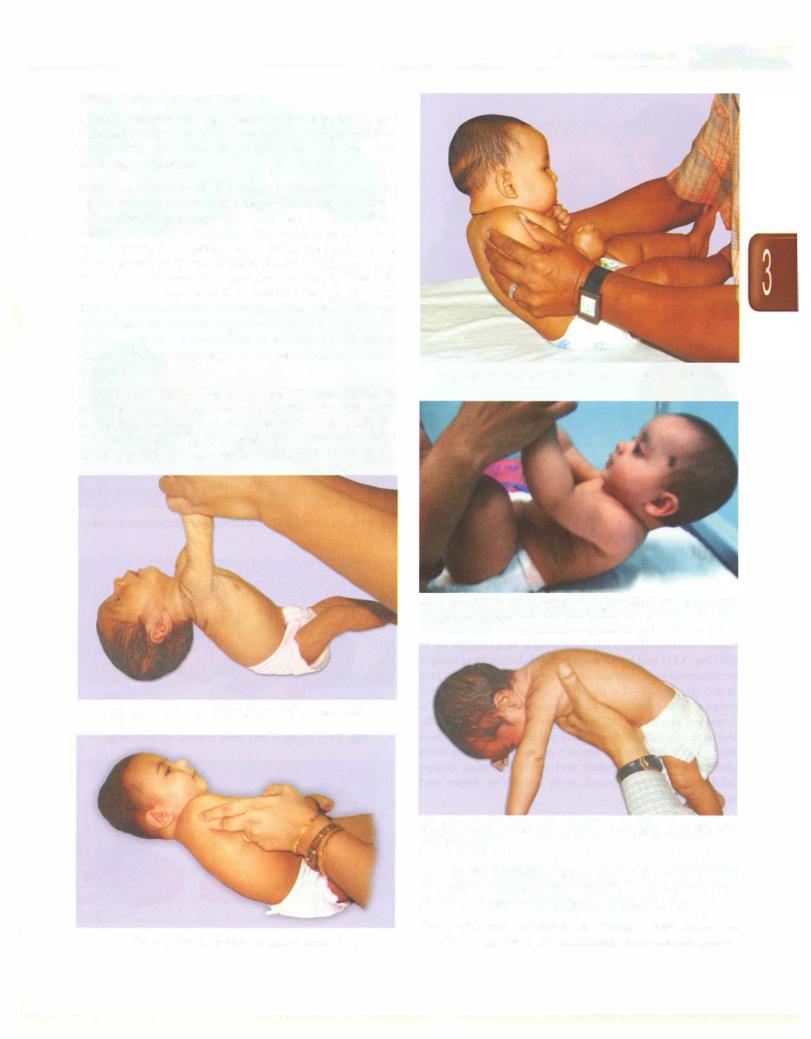
--------------------------------------D_e_v_e_io_p_m_e_n_.....t -
Gross Motor Development
Motor development progresses in an orderly sequence to ultimate attainment of locomotion and more complex motor tasks thereafter. In an infant it is assessed and
observed as follows: |
|
Supine and pull to sit The infant is observed in supine |
|
and then gently pulled to sitting position. Control of head |
|
and curvature of the spine is observed. In the newborn |
|
period, the head completely lags behind and back is |
|
rounded (Fig. 3.2). Starting at 6 weeks, the head control |
|
develops and by 12 weeks there is only a slight head lag. |
|
The spine curvature also decreases accordingly (Fig. 3.3). |
|
The child has complete neck control by 20 weeks (Fig. 3.4). |
|
This can be ascertained by swaying him gently 'side-to |
|
side' when sitting. At this age, the baby loves to play with |
|
his feet, and may take his foot to mouth as well. Infant |
|
lifts head from the supine position when about to be pulled |
|
at 5 months (Fig. 3.5). |
Fig. 3.4: Pull to sit; flexes the head on to chest at 5 months |
|
|
Ventral suspension The child is held in prone position |
|
and then lifted from the couch, with the examiner |
|
supporting the chest and abdomen of the child with the |
|
palm of his hand. Up to 4 weeks of age, the head flops |
|
down (Fig. 3.6). At 6 weeks, the child momentarily holds |
|
Fig. 3.5: Infant lifts head from the supine position when about to be pulled at 5 months
Fig. 3.12: Pull to sit; complete head lag in a newborn
|
Fig. 3.6: Ventral suspension; unable to hold neck in the line with |
|
trunk at 4 weeks |
|
head in the horizontal plane and by 8 weeks, he can |
|
maintain this position well (Fig. 3.7). By 12 weeks, he can |
|
lift his head above the horizontal plane (Fig. 3.8). |
|
Prone position At birth or within a few days, the |
Fig. 3.3: Pull to sit; no head lag at 4 months |
newborn turns the head to one side. At 2 weeks, the baby |
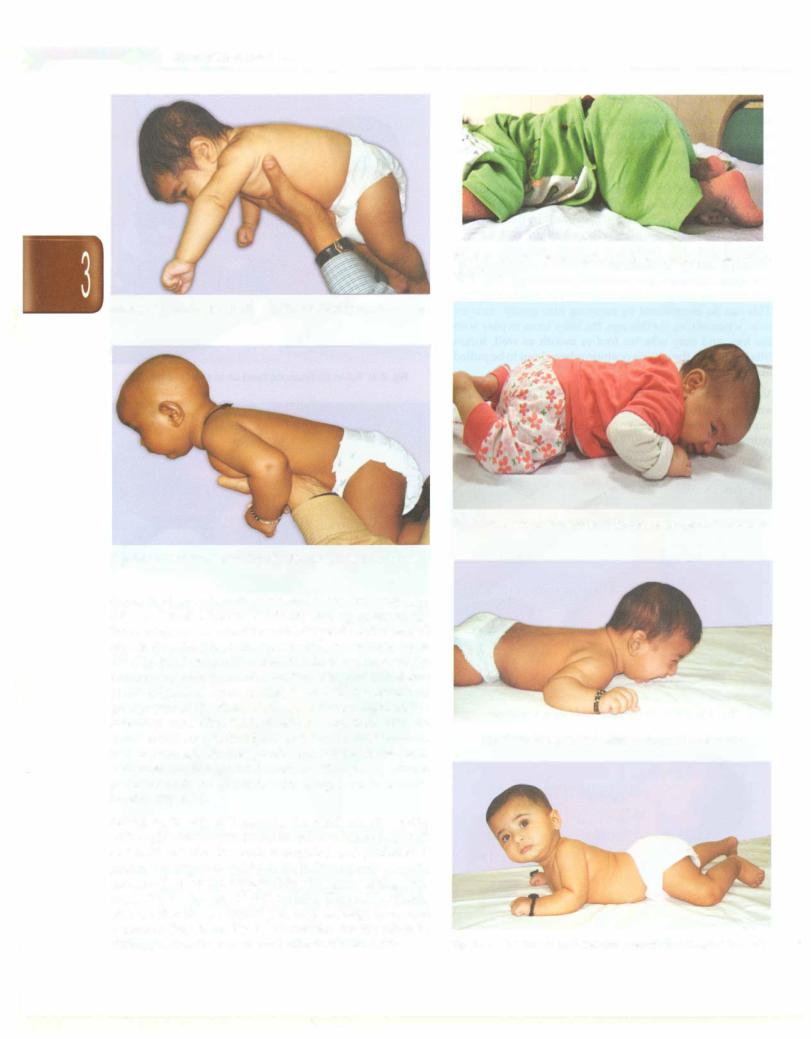
--E-sse__nt i_a,_P_ediatrics· --------------- |
---- |
- |
-------------- |
|
|
Fig. 3.9: The infant lies on the bed with high pelvis and knees drawn up at 2 weeks
Fig. 3.7: Ventral suspension; head in line with the trunk at 8-10 weeks
Fig. 3.10: The infant lies with flat pelvis and extended hips at 6 weeks
Fig. 3.8: Ventral suspension; head in line with the trunk at 12 weeks
lies on the bed with high pelvis and knees drawn up (Fig. 3.9). At 4 weeks, the infant lifts the chin up momentarily in the midline. Theinfantlies with flat pelvis and extended hips at 6 weeks (Fig. 3.10). By 8 weeks, face is lifted up at 45° (Fig. 3.11) and by 12 weeks, the child can bear weight on forearms with chin and shoulder off the couch and face at 45° (Fig. 3.12). At 6 months, he can lift his head and greater part of the chest while supporting weight on the extended arms (Fig. 3.13). Between 4 and 6 months, he learns to roll over, at first from back to side and thenfrom back to stomach. By the age of 8 months, he crawls (with abdomen on the ground) and by 10 months, creeps (abdomen off the ground, with weight on knees and hands) (Fig. 3.14).
Sitting By the age of 5 months, the child can sit steadily with support of pillows or the examiner's hands (Figs 3.15 and 3.16). At first the back is rounded but gradually it straightens (Figs3.15 and3.16). He independently sitswith his arms forward for support (tripod or truly 'sitting with support') by the age of 6-7 months (Fig. 3.17). Steady sitting without any support generally develops at around 8 months (Fig. 3.18). By 10-11 months, he can pivot in sitting position to play around with toys (Fig. 3.19).
Fig. 3.11: In prone: face lifted to about 45° at 8 weeks
Fig. 3.12: In prone: face, head and chest off the couch at 3 months
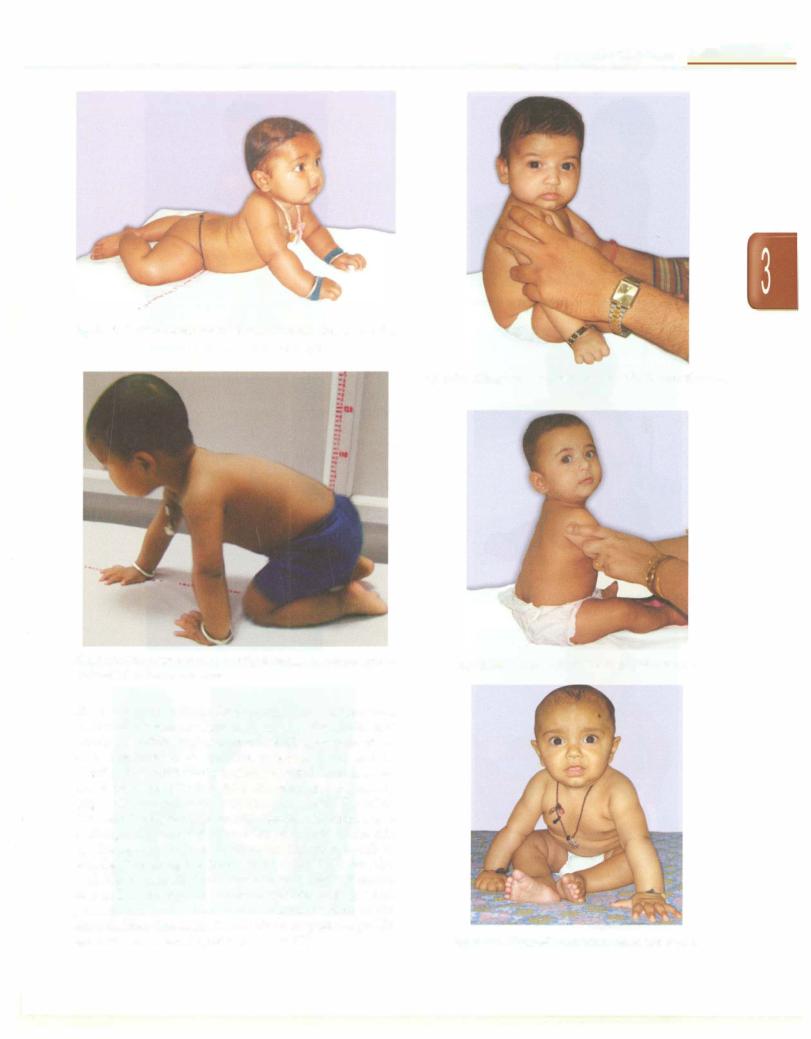
___________________________________o_ e_v_e _io_p_m_en t _
Fig. 3.13: In prone: weight on hands with extended arms at 6 months
Fig. 3.15: Sitting; back rounded but able to hold head at 8 weeks
Fig. 3.14: Creep position at 10 months of age (abdomen off ground |
Fig. 3.16: |
Sitting; back much straighter at 4 months |
|
and weight on hands and knees |
|||
|
|
Standing and walking By 6 months, the child can bear almost all his weight when made to stand (Fig. 3.20). At 9 months, the child begins to stand holding onto furniture and pulls himself to standing position. By 10 and 11 months, the child starts cruising around furniture. At about 12-13 months the child can stand independently (Fig. 3.21) and can walk with one hand held (Fig. 3.22). Between the ages of 13 and 15 months the child starts walking independently. He runsby 18 months and at this age he can crawl up or down stairs and pulls a doll or wheeled toy along the floor. By 2 yr, the child can also walk backwards. He climbs upstairs with both feet on one step at 2 yr. By 3 yr he can climb upstairs with one foot per step and by 4 yr he can move down the stairs in the same fashion (Fig. 3.23). He can ride a tricycle at 3 yr. He can hop at 4 yr and skip at 5 yr (Table 3.1).
Fig. 3.17: Sitting with support of hands at 6 months
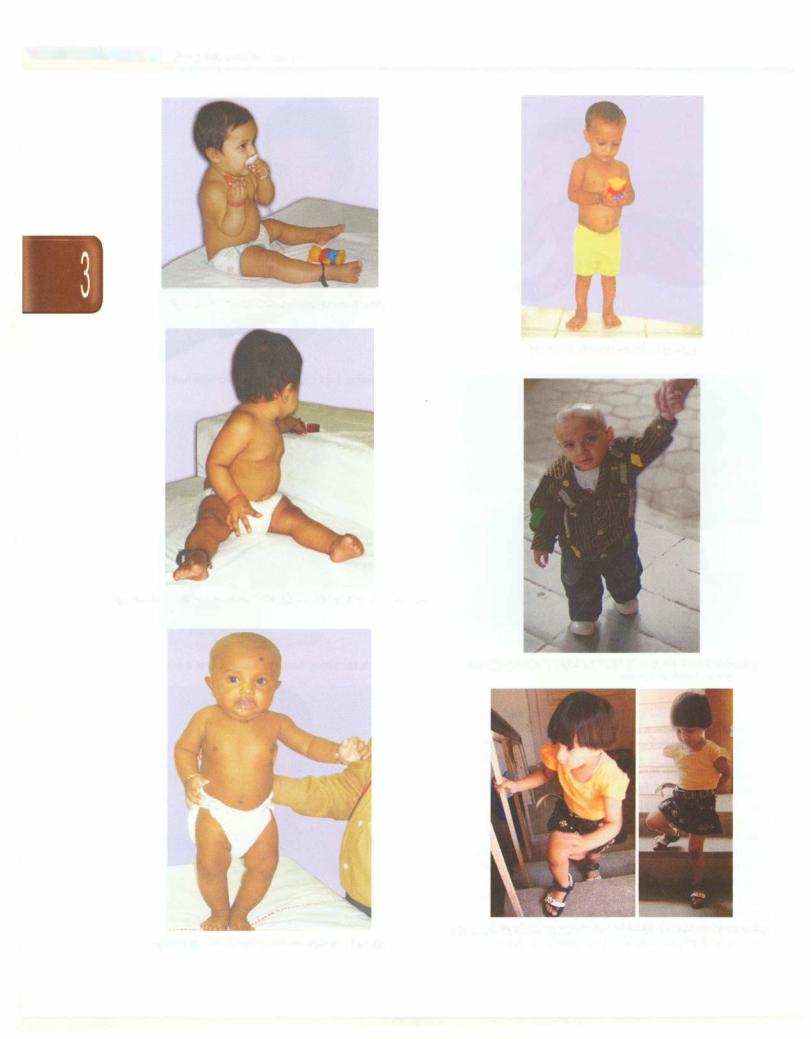
E |
s |
________________ |
__________ |
_ |
_s_s_ en__t_ia_iP_ed ai.t.ri_c |
|
|
||
|
|
|
Fig. 3.18: Sitting without support at 8 months
Fig. 3.21: Stands well at 12 months
Fig. 3.19: Pivoting; turns around to pick up an object at 11 months
Fig. 3.22: Child walking with one hand-held at 12-13 months
|
Fig. 3.23: The child is able to walk upstairs and downstairs one foot |
Fig. 3.20: Bears almost entire weight at 6 months |
per step at 4 yr |
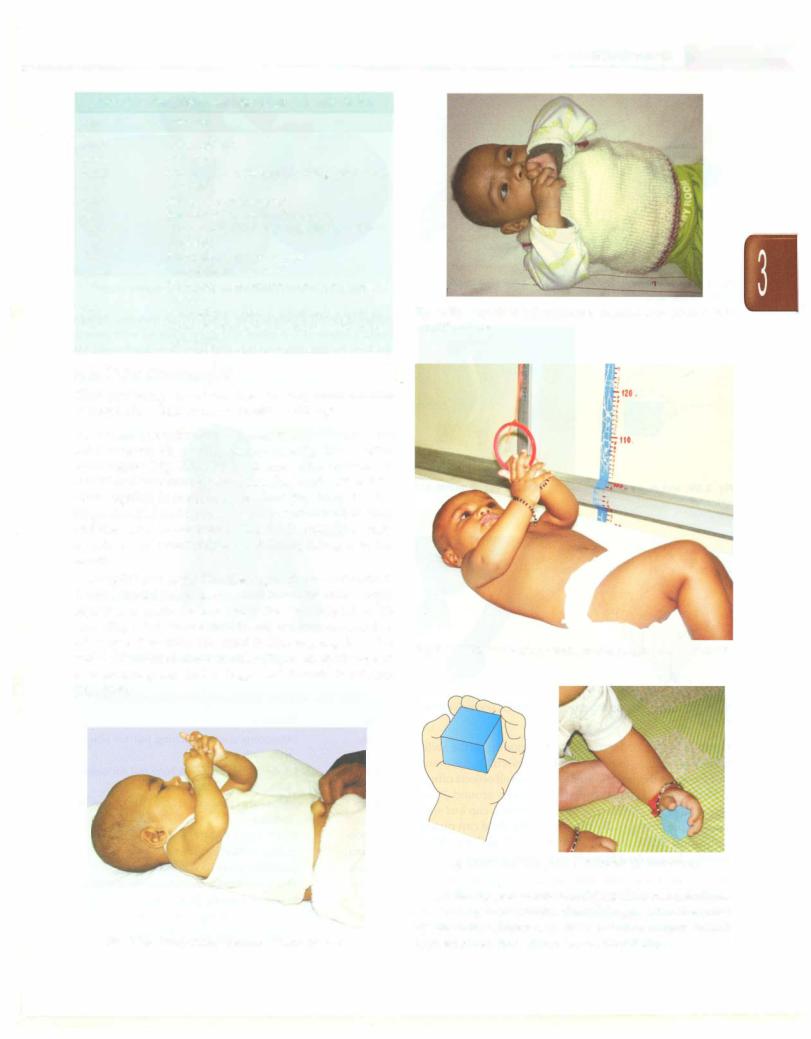
--------------------------------------0-e_v_e_io_p_m_en_t__
Table 3.1: Key gross motor developmental milestones |
|
|
Age |
Milestone |
|
3mo |
Neck holding |
|
Smo |
Rolls over |
|
6mo |
Sits in tripod fashion (sitting with own |
|
|
support) |
|
8mo |
Sitting without support |
|
9mo |
Stands holding on (with support) |
|
12mo |
Creeps well; walks but falls; stands without |
|
|
support |
|
15mo |
Walks alone; creeps upstairs |
|
18mo |
Runs; explores drawers |
|
2yr |
Walks up and downstairs (2 feet/step); |
|
|
jumps |
|
3yr |
Rides tricycle; alternate feet going upstairs |
Fig. 3.25: The child brings hands in midline as he plays at 3 to |
4 yr |
Hops on one foot; alternate feet going |
4 months of age |
|
downstairs |
|
Fine Motor Development
This primarily involves the development of fine manipulation skills and coordination with age.
Hand eye coordination Between 12 and 20 weeks, the child observes his own hands very intently, this is called hand regard (Fig. 3.24). Its persistence after 20 weeks is considered abnormal. At 3 to 4 months, hands of the child come together in midline as he plays (Fig. 3.25). If a red ring is dangled in front of him, he fixes his attention on it, and then tries to reach for it (Fig. 3.26). Initially he may overshoot but eventually he gets it and brings it to his mouth.
Grasp is best assessedbyofferinga red cubeto thechild. |
|
|
A 6-month-old infant reaches and holds the cube (larger |
|
|
object) in a crude manner using the ulnar aspect of his |
|
|
hand (Fig. 3.27). He can transfer objects from one hand to |
|
|
other by 6-7 months. The child is able to grasp from the |
Fig. 3.26: Bidextrous grasp approach to a dangling ring at 4 months |
|
radial side of hand at 8--9 months (Fig. 3.28). By the age of |
||
|
||
1 yr mature grasp (index finger and thumb) is evident |
|
|
(Fig. 3.29). |
|
|
Fig. 3.27: Immature grasp at 6 months (palmar grasp) |
|
By offering pellets (smaller object), finerhand skills are |
|
assessed. By 9-10 months, the child approaches the pellet |
|
by an index finger and lifts it using finger thumb |
Fig. 3.24: Hand regard (between 12 and 20 weeks) |
apposition, termed 'pincer' grasp (Fig. 3.30). |
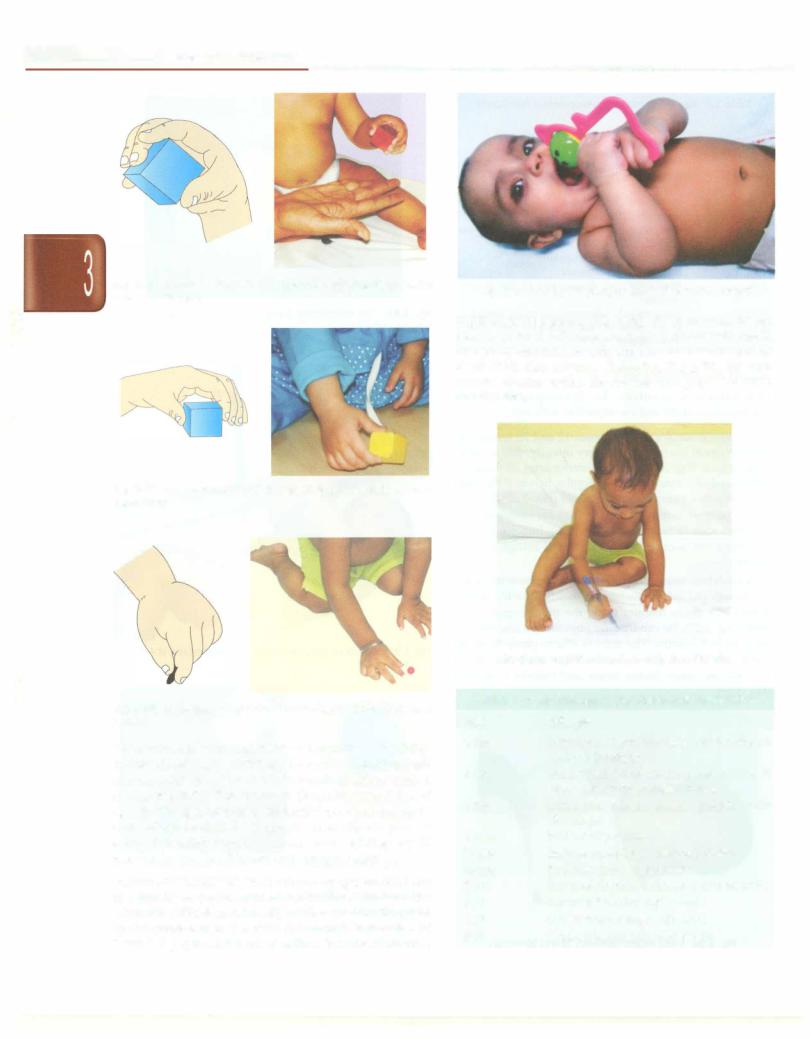
- Es s e n tia l Pe d i a trics |
|
||||
L..::: |
: : |
:,:::,:::,::,:_;:.; |
: :: : |
|
________________________________ |
|
|
:;:_ |
|||
Fig. 3.28: Intermediate grasp at 8 months, beginning to use radial |
Fig. 3.31: A child mouthing an object at 6 months of age |
|
aspect of the hand |
||
|
||
|
paper if given a pencil (Fig. 3.32). By 18 mont s, he c n |
|
|
build a tower of 2-3 cubes and draw a stroke with pencil. |
|
|
By 2 yr, he can unscrew lids and turn door knobs and his |
|
|
block skills also advance (Table 3.2, Fig. 3.33). He now |
|
|
draws a circular stroke. He now can turn pages of a book, |
|
|
one at a time. |
Fig. 3.29: Mature grasp at 1 yr of age, note the use of thumb and index finger
Fig. 3.30: Pincer grasp approach to small objects (index finger and thumb)
Hand-to-mouth coordination At 6months,as theability to chew develops, the child can take a biscuit to his mouth andchew. At this age, he tends to mouth all objects offered to him (Fig. 3.31). This tendency abates by around 1 yr of age. By this age, he tries to feed self from a cup but spills some of the contents. By 15 months, the child can pick up a cup and drink from it without much spilling. By 18 months, he can feed himself well using a spoon.
With advancing age, the child can use hands to perform finer activities. Much of the advanced skills depend partly on the opportunity given by the caretakers to the child. At around 15 months, he turns 2-3 pages of a book at a time and scribbles on a
Fig. 3.32: Scribbles spontaneously at 15 months
Table 3.2: Key fine motor developmental milestones
Age |
Milestone |
4mo |
Bidextrous reach (reaching out for objects |
|
with both hands) |
6mo |
Unidextrous reach (reaching out for objects |
|
with one hand); transfers objects |
9mo |
Immature pincer grasp; probes with |
|
forefinger |
12mo |
Pincer grasp mature |
15mo |
Imitates scribbling; tower of 2blocks |
18 mo |
Scribbles; tower of 3 blocks |
2yr |
Tower of 6 blocks; vertical and circular stroke |
3 yr |
Tower of 9blocks; copies circle |
4yr |
Copies cross; bridge with blocks |
5yr |
Copies triangle; gate with blocks |

Fig. 3.33: A child makes tower of 5-6 cubes at 2 yr of age
Drawing and block skills at various ages are shown in Figs 3.34 and 3.35, respectively. In general copying of the skill comes 6 months after imitating the skills (doing it while seeing).
Dressing Between 18 and 30 months of age, children are very eager to learn dressing skills. Undressing being
/ () |
o_e_v_e |
_,o_p_m_e n |
t |
|
|
|
|
||||
+ |
41/, yr |
|
|||
|
|||||
3 yr |
4 yr |
|
|||
|
|
|
|
|
|
D |
|
:TJ |
|
||
0 |
n |
|
|||
5 yr |
6 yr |
7 yr |
|
||
|
9 |
yr |
|
|
|
8 yr |
11 yr |
|
|||
|
|
||||
|
|
|
|
|
|
Fig. 3.34: |
Drawing skills at various ages |
|
|||
easier, is learned before dressing. At 1 yr the child starts to pull off mittens, caps and socks. At around 18 months, he can unzip, but fumbles with buttons. By 2 yr, he can
15 months |
18 months |
2 yr (train) |
|
(tower of 2 blocks) |
(tower of 3 blocks) |
||
|
/I
J
2,t yr (train with chimney) |
3 yr (bridge) |
4 yr (gate) |
6 yr (steps) |
3 y r |
|
(tower of 9 blocks) |
|||
|
|
||
|
|
|
|
|
Fig. 3.35: Block skills at various ages |
|
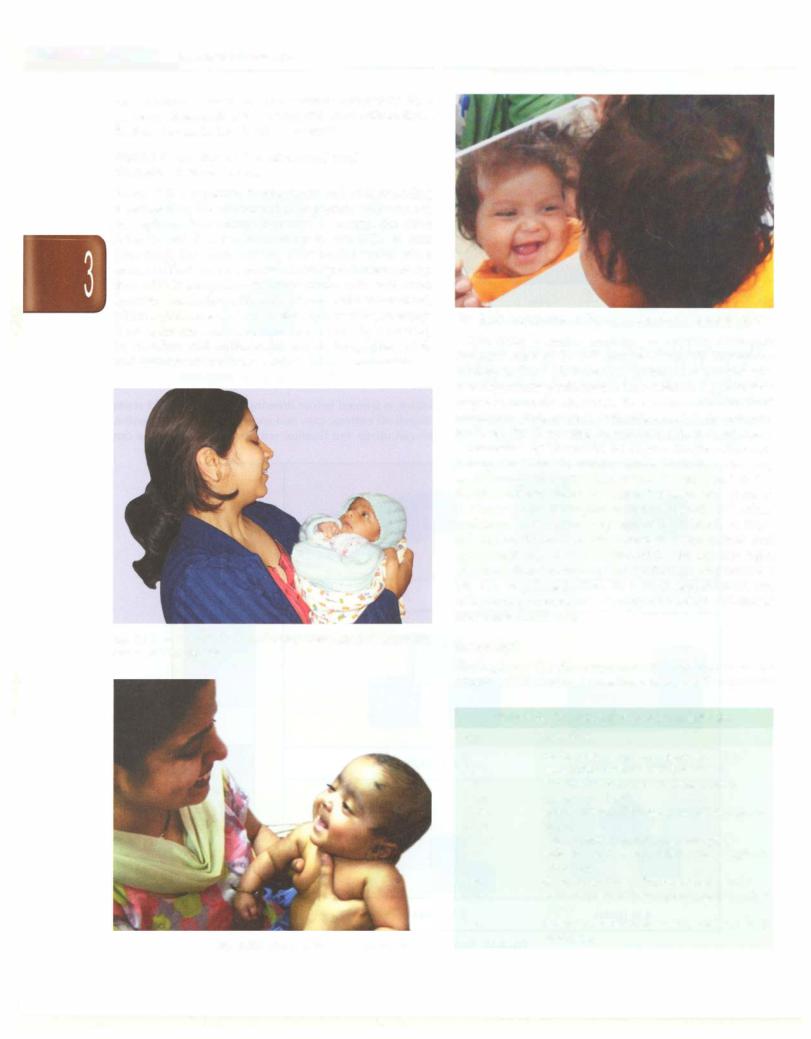
|
|
|
s |
|
|
_______________ |
|
E s s e n tia P e d i atric |
___________ |
_ |
|||
|
___ |
_ _ _ _ _ _ _ _ _ _ _ _ _ - |
_ |
______ |
|
|
|
|
|
||||
put on shoes or socks and can undress completely. By 3 yr, he can dress and undress fully, if helped with buttons. By 5 yr, he can tie his shoelaces as well.
Personal and Social Development and
General Understanding
Much of the cognitive development and understanding is reflected by the attainment of important milestones in this sphere. Beginning at around 1 month, the child intently watches his mother when she talks to him (Fig. 3.36). He starts smiling back (social smile) when anyone talks to him or smiles at him by 6-8 weeks of age (Fig. 3.37). It is important to differentiate social smile from spontaneous smile (smile without any social interaction), which is present even in neonates. By 3 months, he enjoys looking around and recognizes his mother. By 6 months, he vocalizes and smiles at his mirror image (Fig. 3.38), and imitates acts such as cough or tongue protrusion.
Fig. 3.36: At 1 month, the babyshowing intent regard of his mother's face as she talks to him
Fig. 3.37: Social smile
Fig. 3.38: A child smiles at himself in the mirror at 6 months of age
The child becomes anxious on meeting strangers (stranger anxiety) by 6-7 months of age. At this age he inhibits to "no". At 9 months, he waves "bye-bye" and also repeats any performance that evokes an appreciative response from the observers. By 1 yr, he can understand simple questions, such as "where is papa", "where is your ball", etc. By 15 months, he points to objects in which he is interested. By 18 months, he follows simple orders and indulges in domestic mimicry (imitates mother sweeping or cleaning). At 2 yr, when asked he can point to 5-6 familiar objects, name at least 2-3 objects and point to 3--4 body parts. He begins to count, identify 1-2 colors and sing simple rhymes by age of 3 yr. Much of these milestones depend on the caretaker's interaction and opportunities provided to the child. The left and right discriminationdevelopsby4 yr. By this age, play activities are also very imaginative. By 5 yr of age, children can follow 3 step commands, identify four colors and repeat four digits (Table 3.3).
Language
Throughout the development of language it is the receptive ability and understanding which precedes expressive
Table 3.3: Key social and adaptive milestones
Age |
Milestone |
2mo |
Social smile (smile after being talked to) |
3mo |
Recognizes mother; anticipates feeds |
6mo |
Recognizes strangers, stranger anxiety |
9mo |
Waves "bye bye" |
12mo |
Comes when called; plays simple ball game |
15mo |
Jargon |
18mo |
Copies parents in task (e.g. sweeping) |
2yr |
Asks for food, drink, toilet; pulls people to |
|
show toys |
3yr |
Shares toys; knows full name and gender |
|
|
4 yr |
Plays cooperatively in a group; goes to toilet |
|
alone |
5yr |
Helps in household tasks, dresses and |
|
undresses |
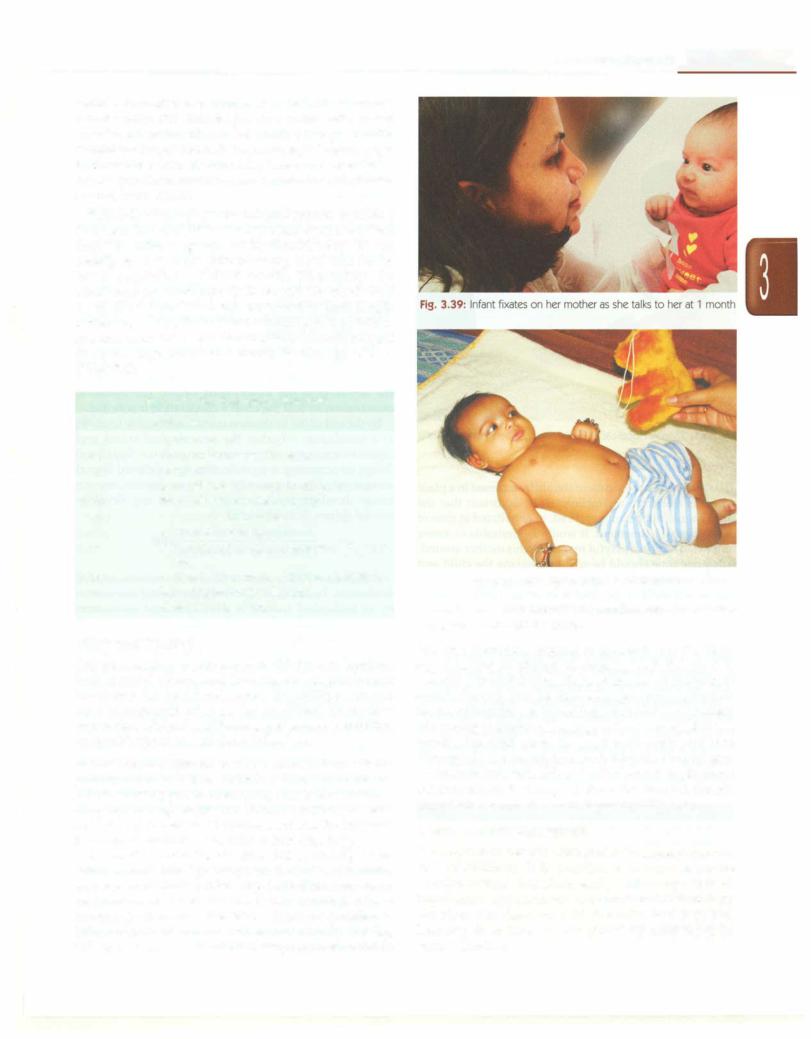
abilities. Soon after appearance of social smile at around 6 to 8 weeks, the child begins to vocalize with vowel sounds such as 'ah, uh'. At 3-4 months, he squeals with delight and laughs loud. He begins to say 'ah-goo', 'gaga' by 5 months of age. By 6 months, he uses monosyllables (ba, da, pa). Later, he joins consonants to form bisyllables (mama, baba, dada).
Before developing true meaningful speech, at around 9-10 months the child learns to imitate sounds derived from his native language. At his first birthday, he can usually say 1-2 words with meaning. At 18 months, he has a vocabulary of 8-10 words. Thereafter, the vocabulary increases rapidly to around 100 words by 2 yr, at which time 2-3 words are joined to form simple sentences. By3 yr, the toddler continually asks questions and knows his full name. He can give a coherent account of recent experiences and events by the age of 4 yr (Table 3.4).
|
Table 3.4: Key language milestones |
Age |
Milestone |
1 mo |
Alerts to sound |
3mo |
Coos (musical vowel sounds) |
4mo |
Laugh loud |
6mo |
Monosyllables (ba, da, pa), ah-goo sounds |
9mo |
Bisyllables (mama, baba, dada) |
12mo |
1-2words with meaning |
18mo |
8-10word vocabulary |
2yr |
2-3word sentences, uses pronouns" I","me", |
|
"you" |
3yr |
Asks questions; knows full name and gender |
4yr |
Says song or poem; tells stories |
5 yr |
Asks meaning of words |
Vision and Hearing
Adequate sensory inputs are essential for development. Both normal vision and hearing are of paramount importance for child development. The ability to see and hear is apparent even in the newborn. Thereafter maturation of visual and hearing pathways are reflected by specific visual and auditory behaviors.
Vision The best stimulus to check visual behavior is the primary caretaker's face. At birth, a baby can fixate and follow a moving person or dangling ring held 8-10 inches away up to a range of 45°. This increases to 90° by4 weeks and 180° by 12 weeks. At around 1 month, the baby can fixate on his mother as she talks to him(Fig. 3.39).
At about 3-4 months, the child fixates intently on an objectshownto him('graspingwith the eye') as if thechild wants to reach for the object(Fig. 3.40). Binocular vision begins at around 6 weeks and is well established by 4 months. By 6 months, the child adjusts his position to follow objects of interest, can follow rapidly moving objects by 1 yr. Later the child displays more maturity in
o_ev_e_io_p_m_e_n_t __
Fig. 3.40: Grasping 'with the eye' at 3 months
vision by not only identifying smaller objects but also being able to recognize them.
Hearing Newborns respond to sounds by startle, blink, cry, quieting or change in ongoing activity. By 3 to 4 months, the child turns his head towards the source of sound. Hearing, may be checked by producing sound 11h feetawayfromthe ear(out of field of vision), andapattern of evolving maturity of hearing can be observed. At 5 to 6 months the child turns the head to one side and then downwards if a sound is made below the level of ears. One month later he is able to localize sounds made above the level of ears. By the age of 10 months the childdirectly looks at the source of sound diagonally(Fig. 3.41).
Developmental Assessment
Developmental delay is estimated to be present in about 10% of children. It is possible to recognize severe developmental disorders early in infancy. Speech impairment, hyperactivity and emotional disturbances are often not detected until the child is 3-4 yr old. Learning disabilities are not picked up until the child starts schooling.
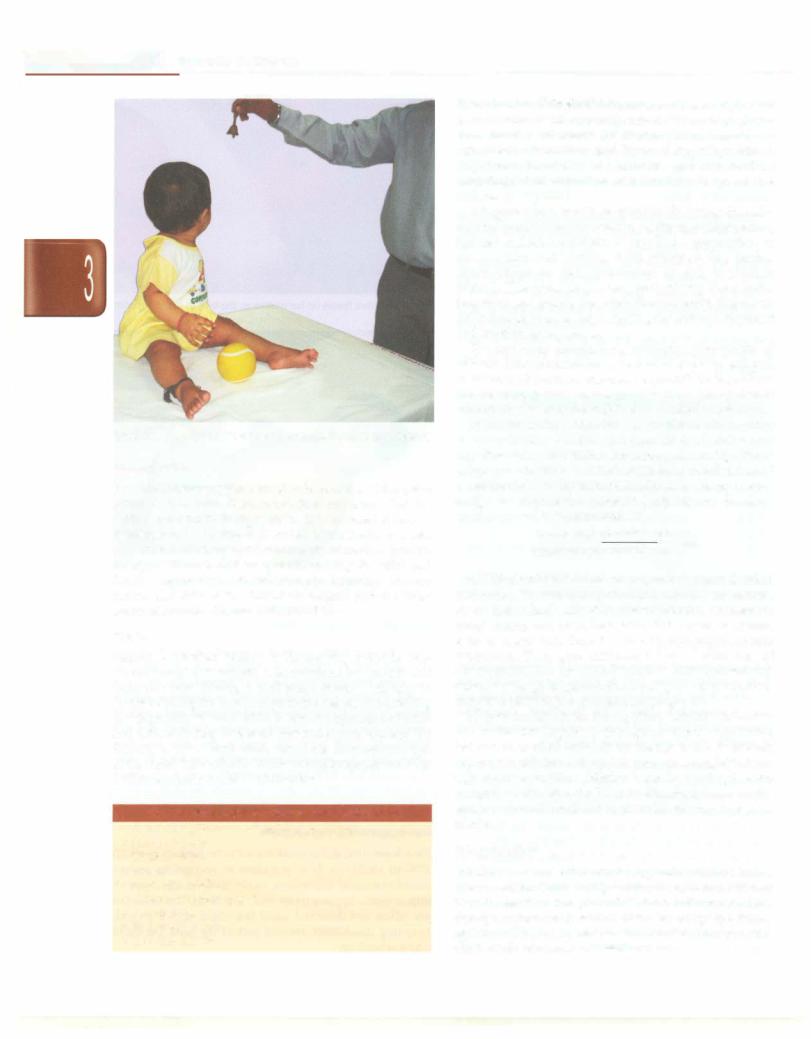
__E_s_s_ e_n_t_ ia_1_Pde _iat _rcis--------------------------- |
------- |
|
Fig. 3.41: Diagonal localization of the source of sound at 10 months
Prerequisites
Thedevelopmentassessmentshould be assessedin aplace which is free from distractions. It is important that the child should not be hungry, tired, ill or irritated at time of development assessment. It would be desirable to assess him when he is in a playful mood with his mother around. Adequate time should be spent in making the child and family comfortable. Observation for alertness, concen tration and skills of the child is an integral part of assess ment carry a development kit (Box 3.1).
Steps
History A detailed history is the starting point for any development assessment. Observations by parents are fairly accurate. Hence, a well taken history will help in
(i) determining the details of probable risk factors affecting development, (ii) evaluation of rate of acquisition of skills and differentiating between delay andregression, and (iii) forming a gross impression about the development age of the child. This helps to choose the appropriate tools for further evaluation and confirmation.
Box 3.1. Equipment for development assessment
•A red ring (diameter 6-7 cm) tied to a string
•Nine red cubes
•Paper pellets
•Spoon
•Cup with handle
•A book with thick pages
•Picture book
•Red pencil, paper
•Doll and mirror
Examination Tlm, should be done to (i) assess physical growth and head circumference, (ii) do a physical assessment, particularly for dysmorphism, stigmata of intrauterine infections and signs of hypothyroidism, (iii) screen for vision and hearing, and (iv) conduct neurological examination and examine for primitive reflexes (if required).
Adequate time should be spent in observing the baby especially social responsiveness, alertness, concentration, interest and distractibility. It would be appropriate to assess vision and hearing at the outset so that further observations are not confounded by lack of sensory stimuli. The vocal responses, particularly the nature, frequencyandquality arenoted. Subsequently,fine motor skills should be assessed, including the interest, alertness and rapidity of responses.
The annoying maneuvers, including assessment of reflexes, headcircumference, ventral suspension and pull to sit should be done at the end. It is preferable to perform the developmental assessment before the systemic examination so that the child's cooperation is solicited.
By the end of the evaluation one shouldbe able to arrive at a conclusion whether the neurological status and cognitive statusarewithin normal range or not. Significant delays on screening is an indication for a detailed formal assessment of development status. Byassessment,one can assign developmental quotient (DQ) for any develop mental sphere. It is calculated as:
Average age at attainment---=----'=-- xlOO
Observed age at attainment
A DQ below 70% is taken as delayandwarrants detailed evaluation. To obtain a DQ of a child, a formal assessment by an individual trained in developmental assessment using appropriate tools/tests is needed. There are several tests to assess DQ. Each test has its own psychometric properties. They give different kinds of estimates of development like an overall score of development and subscores for gross motor, fine motor, visual perception, receptive language, expressive language, etc.
IQ tests mainly assess the cognitive/adaptive behavior part of the development. The age at which a particular test can be applied depends on the test items. However, in younger children (<5 yr), it is more meaningful to have a global assessment of abilities; hence DQ testing is more comprehensive. Specific IQ tests (Stanford-Binet intelli gence scales) are available to asses IQ starting from 2 yr of age.
Interpretation
In babiesbornpreterm,correctedage rather than postnatal age is used for determining developmental status till two years of age. For example, a child born at 32 weeks gesta tion (gestational age) seen at 12 weeks of age (postnatal age) should be consideredas a 4-week-old (corrected age) child for development assessment.
